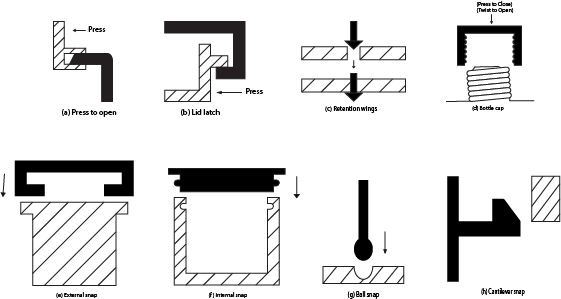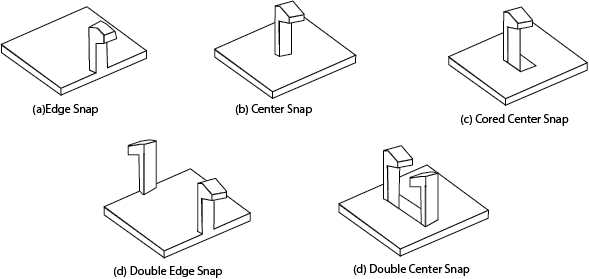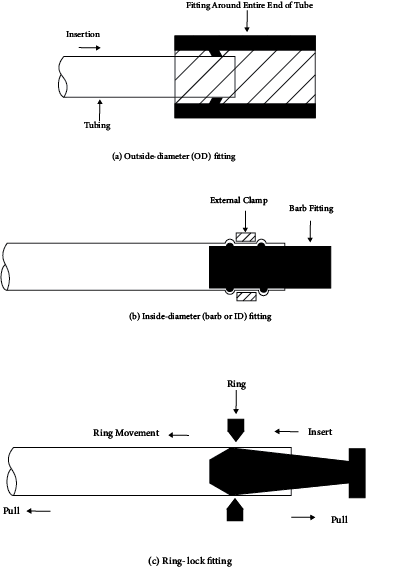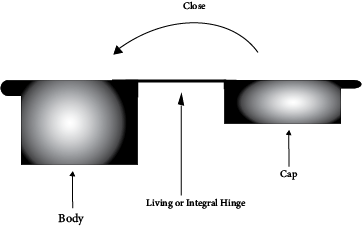Mechanical Joining and Assembly
The principal methods of joining or bonding two materials together can be classified as mechanical joining, adhesive bonding, and nonadhesive bonding. Each of these methods is discussed in the following sections and then compared in a table at the end of the sections. Each of the methods has significant applications with plastics in that plastics are the materials that are joined or bonded and, in some cases, the materials that are the joining or bonding agents.
Mechanical joining and assembly methods for plastics include many also widely used for non plastic parts, such as rivets and threads (developed for metals and modified for plastics). This section discusses traditional mechanical joining methods as they apply to plastics as well as mechanical joining methods that are unique to plastics. Most of these nontraditional joining methods rely on the flexibility of many plastics or some other property of plastics that allows them to be joined into assemblies without the need to bond the components together.
21.6.1. Traditional Joining and Assembly Methods
Joining two plastic parts with rivets or, equivalently, nuts and bolts, is accomplished using the same basic procedure as is used in joining metal parts. Holes are drilled in the parts to be joined, the holes are aligned, and a rivet or bolt is inserted into the hole. The rivet is then capped (flattened or headed) to secure it in place and lock the plastic parts together. If a traditional metal rivet is used as the joining device, head flattening is done mechanically, either on a cold or a heated rivet. If plastics are to be joined, heated rivets are generally not used because they melt the plastics. For bolts, the nut is simply threaded onto the bolt with some care against over tightening.
Plastic rivets and bolts can also be used. The plastic rivet can be heated, provided the temperature is lower than the softening temperature of the plastics to be joined or the contact time at the high temperature is short enough that softening of the parts does not occur. Using a plastic rivet to join plastic parts means that the strength of the rivet will closely match the strength of the plastic. This reduces one of the major problems associated with the use of metal rivets on plastic parts: pulling out of the rivet. The high strength of metal compared to plastic means that any stress placed on the rivet zone may cause the metal rivet to rip through the surrounding plastic part. With plastic rivets, on the other hand, the rivet elongated slightly and may be the breaking point rather than the surrounding plastic material. In either case, rivets used to join plastic parts usually have very wide flanges so that stresses can be spread over a much wider area, helping the joint withstand the stresses without failure of the plastic material. With nuts and bolts, a large washer is used to spread the load.
Plastic parts can also be joined using traditional metal screws. The threads are cut or molded in the plastic parts and then are joined using regular metal screws. Again, plastic screws can also be used. The relatively low strength of plastics can also be a factor in the strength of joints using screws, either metal or plastic. The threads in the plastic materials would be weaker than the screw and pullout by stripping the plastic threads could occur under stress applied to the joint. This problem is reduced by using large, strong thread types. These heavy-duty threads often are widely spaced with heavy ridges, some even square. Although the strength of such heavy-duty threads is increased, the accuracy of the thread system and the tightness and retention of the screw are reduced. Hence, the chance of the thread loosening is much higher with plastic threads than with metal threads.
When long-term tightness is required, inserts with metal threads are used. These inserts are molded or, perhaps, bonded into the plastic material. When appropriately attached, these inserts give the proper anchor for metal screws so that retention and tightness are equivalent to full metal systems. Plastic screws can also be used with metal inserts, but the strength of the assembly would be lower because the plastic screw is generally weaker than the similar metal screw.
Self-threading screws can also be used with many plastic parts. With these, joining (cutting the threads with the screw) is easier than with metals and about the same as with wood. The retention in plastics is about the same as in wood. However, self-threading screws introduce considerable stresses in the plastic. Many plastic materials are highly susceptible to such stresses and could crack easily either during insertion of the self-threading screw or from subsequent activities that might induce additional stresses, even small ones. Therefore, some trials and long-term testing should be done before self-threading screws are used with any plastic.
Plastic fasteners, either rivets, screws, or other fasteners, have some advantages over metal analogues. The plastic fasteners are lighter, corrosionresistant, insulated, flexible, durable, and usually less expensive. These also have the same or similar coefficients of thermal expansion as the plastic parts to be joined, thus eliminating a source of thermal stresses and possible joint movements. The disadvantages of plastic fasteners versus metal fasteners are the lower strength, shear resistance, torque strength, and heat resistance of the plastics.
21.6.2. Nontraditional (Unique to Plastics) Joining and Assembly Methods
The most important and most widely used joining and assembly method unique to plastics is the snap joint, or interference joint. This joint, several types of which are illustrated in Figure 21.3, uses the flexible nature of plastics to create a joint. Because such joints of ten can be opened and closed repeatedly (with the exception of the retention wings), they are valuable as closure devices. The snap fit basically involves an undercut on one part that engages a molded lip on the other part. One snap fit, the cantilever type, is especially common. Figure 21.4 illustrates several configurations of the cantilever snap fit that are useful, depending on the configuration of the part.
Other types of fitting can be used because of the compressibility of plastics. Fittings for semi rigid plastic tubes or hose can be of several types, as shown in Figure 21.5. The first type, called an outside-diameter (OD) fitting, fits over the end of the tubing. 1wo barbs are molded into the inside of the fitting and are sloped so that the tubing can be pressed into the fitting past the barbs. If the tubing is pulled so that it moves out of the fitting, the barbs dig into the surface of the tubing and retain it. The second type of fitting is inserted into the tubing and is called an inside-diameter (ID) or barb fitting. This fitting has barbs on its exterior that match or are slightly larger than the diameter of the tubing. When the ID fitting is forced into the tubing, the tubing expands around the barbs and the barb fitting is held in place. External clamps around the outside and placed between or on top of the barbs further improves the fitting retention and makes the assembly watertight. The third type of tubing fitting is called the ring-lock fitting. This fitting has a ring that is retained on a tapered section of the fitting. (The ring is slightly smaller than the largest dimension of the taper and is put in place by forcing the ring over the taper.) The taper is inserted into the tubing such that the tubing goes between the tapered section and the ring. Then, the tubing is pulled in one direction and the fitting is pulled in the other direction. This pulling action moves the ring against the taper and squeezes the pliable tubing between the ring and the taper, thus securing the fitting.

Figure 21.3 Snap Fits


The living hinge, or integral hinge, is another important method for joining plastics that depends on the flexibility of the plastic materials. This hinge is a connecting strip of plastic between two larger plastic sections. The connecting strip and larger sections are made of the same material without joining; that is, they are molded or formed as a single unit. Immediately after molding, the part is flexed on the hinge to give the proper orientation to the molecules in the hinge region. The molecules should be oriented along the direction of the hinge for maximum hinge flexibility and long life. Figure 21.6 shows a box and lid connected by an integral, or living, hinge. Although many flexible plastic materials can be used to form living hinges, the most common plastic is polypropylene. Polypropylene has superflex life and good flexibility. Other candidate materials, such as polyethylene, tend to crack after repeated flexing. Still others, such as nylon or acetyl, will form living hinges that are very stiff.

Figure 21.5 Three different types of tubing fittings: (a) the outside-diameter (OD) fitting, the inside-diameter (ID or barb) fitting, and the ring-lock fitting.


Figure 21.6 A small box and top using an integral, or living, hinge.
